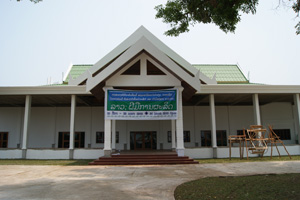
写真1
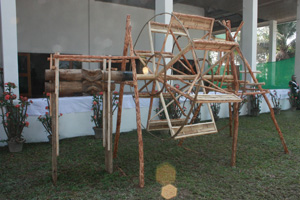
写真2
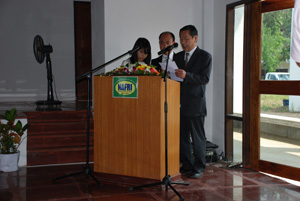
写真3
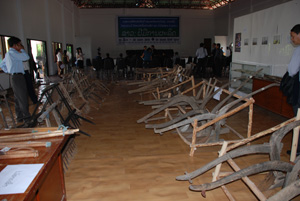
写真4
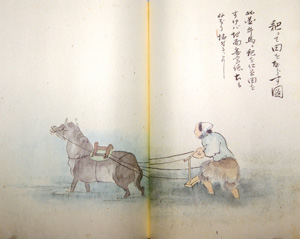
写真5
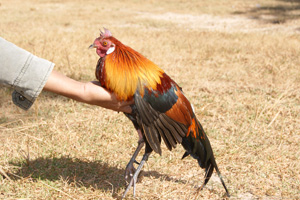
写真6
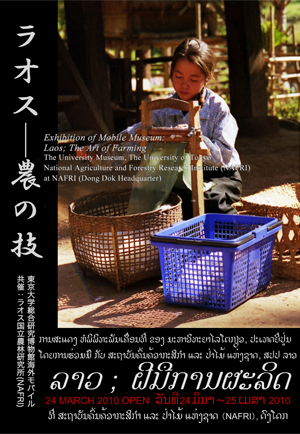
展示ポスター
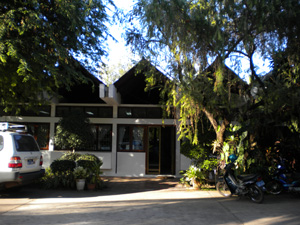
写真7
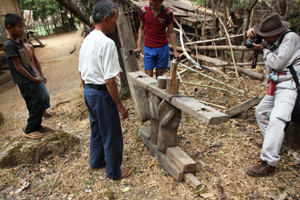
写真8
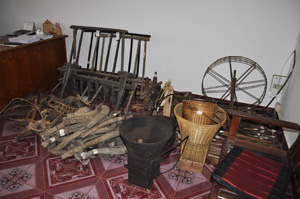
写真9
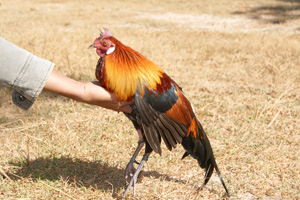
写真10
「ラオス−農の技 Laos; The Art of Farming」
日時:2010年3月24日から4月23日(一般公開は4月19日まで)
場所:ラオス人民民主共和国ヴィエンチャン首都区サイターニー郡・国立農林研究所
(National Agriculture and Forestry Institute: NAFRI)ドンドーク本部構内講堂
本展示は、当館とラオス農林省国立農林研究所(National Agriculture and Forestry Institute: NAFRI)との学術交流協定に基づき、今年が日・ラオス外交関係樹立55周年にあたることから「ラオスと日本における農耕技術の文化的交流」の題目で実施した現地調査により蒐集した農具のコレクションを中心に、ラオスの生態的多様性に支えられた文化的多様性に富む伝統的農耕技術を現地の人々にも再発見してもらうとともに、失われつつあるこれらの技術と生産工具を記録・保存することを目的としている。
2009年7月、本展示およびこのコレクションに係る現地調査の実施について現地側と合意し、11月より約一ヶ月の現地調査をほぼ全国にわたって行い、農具等の主な展示資料を蒐集した。また同年末には、先の調査時にもれた地域での蒐集を引続き行った。
本展示では、主に上記2回を通じて蒐集した約200点の生産工具類および写真パネルを「稲作と社会」「工芸作物の利用」「人と動物との関わり」のテーマに分けて陳列し、これに併せて『農業全書』(文化12年板)および『民家検労図』(復刻版)の原本のほか、江戸時代の農書に採録された生産工具と技術をパネルによって展示し、日本の伝統農法とラオスとの比較を行うとともに、在来技術に関するアーカイブス化の事例として紹介した。
また、当館では2007年よりNAFRIとの共同プロジェクト「ラオスにおける総合的野鶏研究」を実施しており、この成果発表の一部として、この地域を代表する生態資源の一例であるセキショクヤケイ(赤色野鶏)の剥製7体も併せて展示した。
3月24日の開会式では、来賓としてポーンメーク・ダラーローイ=ラオス日本友好協会長(保健大臣)・宮本正明ラオス駐箚日本国大使らを迎え、本館特招研究員である秋篠宮文仁親王殿下ならびに眞子内親王殿下の御臨席を得て、日本側林良博当館館長(当時)、ラオス側ブントーン・ブアホームNAFRI所長の主催者挨拶に続いて内覧会を行い、この後、シタヘン・ラーサポン農林大臣の発声により、この地域と日本との交流を示す一例として泡盛で乾杯した。
今回の展示は、NAFRIにとっては初めての試みであったが、政府から高く評価されたこともあって、これを契機に今後も調査と資料蒐集の継続に意欲を示しており、民俗資料の価値とその記録・保存の意義について再認識されたことは、本事業の大きな成果と考えられる。
園江 満(東京大学総合研究博物館研究事業協力者・東京農業大学国際食料情報学部非常勤講師・東京外国語大学アジア・アフリカ言語文化研究所共同研究員、農業地理学・タイ研究Tay Studies)
■ 写真解説(上から)
1. 展示会場となったラオス農林省国立農林研究所本部講堂
NAFRIは、ヴィエンチャン首都区ドンドークの本部地区のほか8部門の研究センターと南部・北部地域センターからなる。(園江満撮影)
2. 開場入口に設置した甘蔗圧搾機(搾糖機)
平行ウォーム(螺旋状)歯車を持った2ローラー横臥式水力駆動甘蔗圧搾機。本来は川の流れの中に足場を組んで設置する。(NAFRI提供)
3. 開会式で主催者挨拶をする林良博館長(恒川直樹撮影)
4. 展示会場の様子
右手手前から奥に南−北にかけての犂(すき)の形状変化にあわせて直線的に陳列した。同様に左奥は而字型耙(まぐわ)、手前にあるのは脱穀用稲巻棒。(恒川直樹撮影)
5. 農書に見る日本の伝統農具
今回展示した『民家検労図』(1830頃)復刻版(1995)天の巻より「耙にて田をならす図」(パネル展示)。
6. 成熟したオスのセキショクヤケイ(カムアン県ヒンブーン郡)
家鶏に比較して細く滑らかな脚が特徴的で、特に、成熟したオスは先鋭な蹴爪を持っている。(園江満撮影)
■ プロジェクトメンバー
園江 満・遠藤秀紀・恒川直樹
■ 協力
ラオス文化振興財団・ラオス教育振興財団
■ 展示協力
加藤高志・虫明悦生・富田晋介
TITLE OF MOBILE MUSEUM:
Laos; The Art of Farming
DATE: 24th March – 23rd April 2010
PLACE: The Auditorium of Dong Dok Headquarter, National Agriculture and Forestry Institute (NAFRI), Ministry of Agriculture and Forestry, Xaythani District, Vientiane Capital, the Lao People’s Democratic Republic
On the occasion of the 55th anniversary of Japan-Lao Diplomatic Relation, this exhibition according as MOU of academic exchange between UMUT and National Agriculture and Forestry Institute (NAFRI), the Lao People’s Democratic Republic had been based on the field research on the subject of “Cultural Intercourse on Farming Technology between Lao and Japan”. The object of this project shall make people to recognize cultural variation of traditional farming technology and local knowledge in Laos backed with ecological diversity to record and to preserve those technologies and production implements which have been vanishing.
In July 2009, we had reached an understanding with NAFRI about the exhibition and conducting concerned field research. From November 2009, we had conducted field research to collect the samples i.e. production implements almost of whole country of Lao P.D.R. for one month. And, in the end of 2009, supplemental field survey had been held in the outside of the first research area.
In this exhibition, almost 200 items of production implements collected through field researches above and panels have been displayed along the section of “Rice Culture and Human Society”, “Usage of Industrial Crops” and “Domestication of Animals”. And, for introducing the books as an example of compilation of traditional technology, Nogyo-zensho [Encyclopedia of Agriculture] edition of the 12th year of Bunka(1815), Minka Ken-ro Zu [Illustration in the Popular Working] (reprint, original print in c.a. 1830) and other original copies of old books of agriculture and panels also had been displayed.
On the other hand, UMUT have been conducting joint research project entitled “Studies on the Domestication of the Fowl Population” cooperate with NAFRI from 2007. 7 specimens of red jungle fowl which have been a typical natural resource in this area as one of the result of this research project had been displayed in the exhibition.
In the presence of H.I.H. Prince Akishino, Honorary Fellow of UMUT and H.I.H. Princess Mako of Akishino, opening ceremony had been held on 24th March, with attending of H.E. Dr. Ponmek DALALOY, President of Lao-Japan Friendship Association concurrently Minister of Health and H.E. Mr MIYASHITA Masaaki, Ambassador Extraordinary and Plenipotentiary of Japan to Lao P.D.R. and others as guests of honors. After opening remarks by Prof. HAYASHI Yoshihiro, Director of UMUT and Dr. Bounthong BOUAHOM, Director General of NAFRI, the attendance had previewed the exhibition. And then, a toast with awamori (Okinawan spirituous liquor) which may be one example of the evidence of cultural intercourse between Laos and Japan has been proposed by H.E. Mr Sitaheng RASAPHON, Minister of Agriculture and Forestry.
The curatorial work should be the first experiment for NAFRI, however it had been great success of this exhibition and concerned research that government had acclaimed it as the worthwhileness task. As things turned out, this exhibition makes NAFRI recognize the importance of the archives to record and to preserve folk materials and show a willingness to continue the research it and sample collection.
SONOE Mitsuru, Ph. D. (Research Collaborator, The University Museum, The University of Tokyo (UMUT): Visiting Assistant Professor, Faculty of International Food Studies, Tokyo University of Agriculture: Joint Researcher, Research Institute for Languages and Cultures of Asia and Africa (ILCAA); Agricultural Geography, Tay Studies)
■ Caption of Photos (From Top)
1. The Auditorium of NAFRI Headquarter, the Place for Mobile Museum
NAFRI is consists of Headquarter in Dong Dok, Vientiane Capital, 8 Research Centers and Regional Center for Southern and Northern Area. (Photo by Sonoe M.)
2. Press of Sugarcane, in front of the Main Entrance
Lying Double Rollers-type Water-powered Sugar Press with The Worm Gear. Originally, this device should be set up on scaffoldings in the stream. (Photo by NAFRI)
3. Opening Remark by Prof. HAYASHI Yoshihiro, Director of UMUT (Photo by Tsunekawa N.)
4. The Exhibition Room
Ploughs have been displayed straight by difference in shapes between Southern Laos to Northern Laos from this right side to opposite side. Comb harrows have been in opposite left side as same order and combination threshing sticks have been in this side. (Photo by Tsunekawa N.)
5. Traditional Japanese Farm Implement in Old Book of Agriculture
“Figure of Harrowing Paddy Field” in Minka Kenr?-zu [Illustration in the Popular Working] Vol.1 of 3 (reprint in 1995, original print in c.a.1830) (Sonoe’s collection)
6. Matured Male Red Jungle Fowl (Hin Boun District. Khammuan Province)
In comparison with domestic chickens, jungle fowls have thin and smooth-faced legs. Especially, matured male has sharp spurs. (Photo by Sonoe M.)
■ Project Members
Dr. SONOE Mitsuru: Prof. ENDO Hideki: Dr. TSUNEKAWA Naoki
■ Cooperators
Lao Cultural Foundation (Lao P.D.R.): The Foundation for Promoting Education (Lao P.D.R.)
■ Assistance in Display
Assoc. Prof. KATO Takashi: Mr MUSHIAKE Etsuo: Dr. TOMITA Shinsuke
-----------------------------------------------------------------------------
海外モバイル展示
「ラオス―農の技 Laos; The Art of Farming」
(2010年3月24日−4月23日)
展示ポスター(右図のPDF版)
本展示は、当館とラオス農林省国立農林研究所(National Agriculture and Forestry Institute: NAFRI)との学術交流協定に基づき、今年が日・ラオス外交関係樹立55周年にあたることから「ラオスと日本における農耕技術の文化的交流」の題目で実施した現地調査により蒐集した農具のコレクションを中心に、ラオスの生態的多様性に支えられた文化的多様性に富む伝統的農耕技術を現地の人々にも再発見してもらうとともに、失われつつあるこれらの技術と生産工具を記録・保存することを目的としている。
2009年7月、本展示およびこのコレクションに係る現地調査の実施について現地側と合意し、11月より約一ヶ月の現地調査をほぼ全国にわたって行い主な展示資料を蒐集した。また同年末には、先の調査時にもれた地域での蒐集を引続き行った。当館では、2007年よりNAFRIとの共同プロジェクト「ラオスにおける総合的野鶏研究」を実施しており、この成果発表の一部として、この地域を代表する生態資源の一例であるセキショクヤケイ(赤色野鶏)の剥製も併せて展示の予定である。
また、『農業全書』(文化12年板)および『民家検労図』(復刻版)の原本のほか、江戸時代の農書に採録された生産工具と技術をパネルによって展示し、日本の伝統農法とラオスとの比較を行うとともに、在来技術に関するアーカイブス化の事例として紹介する。
また、これまでのプロジェクト実施にあたっては、現地NPOであるラオス文化振興財団(LCF)およびラオス教育振興財団(FPE)の協力を得ており、この会期中FPEの企画による生徒見学会も予定している。
園江 満(東京大学総合研究博物館研究事業協力者・東京農業大学国際食料情報学部非常勤講師・東京外国語大学アジア・アフリカ言語文化研究所共同研究員、農業地理学・タイ研究Tay Studies)
■ 写真解説(上から)
7
ラオス農林省国立農林研究所本部事務棟(ヴィエンチャン首都区ドンドーク) NAFRIは、本部のほか8部門の研究センターと南部・北部地域センターからなる。海外モバイルは、この本部構内に建設中(2月竣工予定)の講堂を会場として開催する。(園江 満 撮影)
8
現地調査の様子(ファパン県ヴィエンサイ郡) 今回展示予定の、平行ウォーム(螺旋状)歯車を持った甘蔗圧搾機(搾糖機)についての聞取り調査。(加藤高志 撮影)
9
整理中の農具コレクション(ヴィエンチャン首都区ナムスァン・NAFRI畜産研究センター)
左手奥から而字形耙(まぐわ)・綿轆轤(ろくろ)・紡車(いとぐるま)・綿打弓、前列左手奥から頸木(くびき)類・陸稲収穫籠。(遠藤秀紀 撮影)
10
成熟したオスのセキショクヤケイ(カムアン県ヒンブーン郡) 家鶏に比較して細く滑らかな脚が特徴的で、特に、成熟したオスは先鋭な蹴爪を持っている。(園江 満 撮影)
■ プロジェクトメンバー
園江 満・遠藤秀紀・恒川直樹
■ 展示協力
加藤高志

